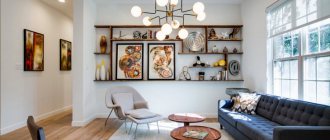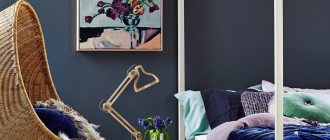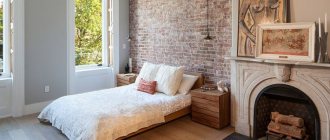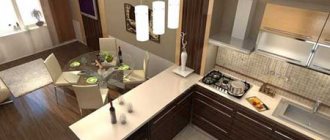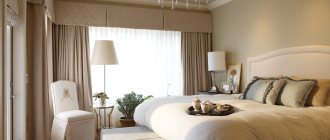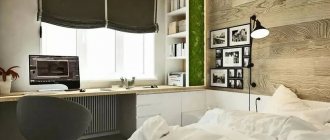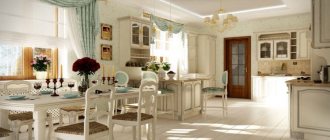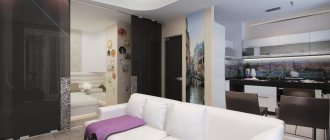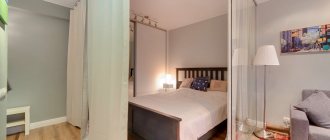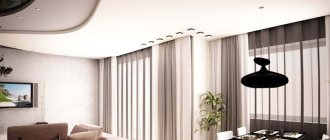Decoration of the ceiling part
The choice of color will depend on the height and area used - light colors (slightly paler than the walls) will help to visually “raise” the ceiling.
If you want the opposite effect, it is not necessary to choose dark colors; it is enough to use warm and rich shades.
- Complicated multi-level structures made of plasterboard or powerful chandeliers in small rooms will look unnatural and heavy.
- In such cases, it would be preferable to opt for a monochromatic or suspended glossy ceiling and built-in spotlights - in combination with the shine of the gloss, such a “cloudy” glow will create the illusion of additional height.
- If you have a large height, you can afford more complex coffered and suspended structures with paintings, chandeliers, volumetric designs that “steal” centimeters, or stucco decorations.
Which walls to choose
When creating the overall picture, the design of the walls in the hall is of no small importance.
The choice of color scheme will depend on many factors:
- Colors of furniture and decorative elements - walls can become a good background or the main accent of the room;
- The size of the room - in cramped spaces, “cold” options are preferred, and a spacious room allows for experiments with many colors;
- Layouts - a room elongated in length is visually corrected by vertical stripes and patterns on the long side or more saturated tones on short sections;
- The amount and nature of natural light - on the sunny side a cold palette looks organic, and cloudy rooms are beneficial for peach, mustard and other shades of yellow.
The texture of the coating will also affect the final result. Many design options are suitable for the hall:
- Paints (water-dispersion, alkyd, silicone or latex, etc.).
- Wallpaper (non-woven, vinyl, regular paper, liquid, photo wallpaper, etc.).
- Decorative plaster.
- Panels made of plastic or wood.
- Finishing with plasterboard sheets, etc.
Interesting combinations are obtained using painting and wallpapering.
Hall floor design
As with the ceiling, the selection of floor color is interconnected with the design of the walls - it is recommended to choose it a couple of shades darker, although an overly dark floor tends to visually make any room smaller and add austerity to it.
From the point of view of receiving a large number of guests, there are also special requirements for floor coverings in this area:
- Wear resistance;
- Maintaining comfort;
- Presentable appearance.
Based on practicality, you can pay attention to laminate, a fairly durable and beautiful material that also has soundproofing characteristics.
Of the high-status coatings, perhaps, parquet can ideally fit into a classic interior - the most “resistant” would be oak or beech.
Natural stone is more appropriate for cases where you plan to host numerous receptions. It is quite acceptable to use combinations of several options, especially when you want to emphasize certain areas.
Zoning
After priorities have been set, it is necessary to separate multifunctional items from each other.
Various solutions can be used as zoning options in the living room of a private house, for example:
- Finish different areas with materials that differ in color.
- Make the ceiling or floor in a separate place two-level.
- Build a plasterboard arch or partition.
- Build a bar counter.
- Place a bookcase, wooden or glass screen.
Lounge area and what is it?
If you do not own a large apartment, but there are days when you want to sit and relax somewhere, then the idea of arranging a lounge area would be an excellent solution. This is a comfortable island that in every way corresponds to the taste preferences of those who will be staying in it for a long time.
Many people, starting to google images for visualization, find large apartments in which entire rooms are allocated for such space. They are usually furnished with various decorative elements, expensive furniture with gilded handles and stuff like that. In fact, everything is not so complicated and pretentious. The lounge area can be absolutely anything, the main thing to consider is its arrangement in such a way that you can get satisfaction. Therefore, she can even have a tiny corner in a studio apartment.
On the balcony
Even if the balcony is not glazed, you can have a pleasant time on it in the summer. It is enough to provide a comfortable seat and a small table. Decorate the space with flowering plants and garlands - and your place for relaxation is ready!
A glazed and insulated loggia provides even more possibilities: here you can relax all year round, equip the interior with a soft couch, add pillows and blankets, bookshelves, and provide an outlet to connect a lamp or laptop.
Modern direction
The basic rule of a modern interior is that all objects and details in the design of the living room of a private house should be practical and cozy.
This direction is characterized by the presence of multifunctional furniture, good equipment, and the latest finishing materials.
Note!
- Ceiling with beams: TOP-170 photos and videos of ideas for decorating a ceiling with beams. Selection of designs for low and high ceilings. Types of materials for beams
Hallway in a private house: nuances of hallway design in a private house. Choice of style and color solutions. Finishing materials. Photo and video reviews
Attic floor: advantages and disadvantages of the attic. Features of the arrangement of the attic floor. Wall decoration and furniture selection (photo + video)
It is important that the room has an open plan. The hall should not be cluttered with partitions, screens and unnecessary pieces of furniture.
You can achieve bright lighting using LED lamps, multi-level lighting, floor lamps and sconces.
Optimal color solutions
It is also worth remembering that the emotional mood of family members will depend on the choice of color palette. It is important that there is no room for irritating, overwhelming or anxiety-inducing shades.
It is better to be more careful when choosing bright colors - sometimes a combination of too saturated colors or sharp contrasts, although it will look stylish, can be very tiring for everyday use.
For many, calmer and “softer” colors can be a win-win option, especially since the hall remains a universal place for rest and relaxation after work and study.
Important! Before determining the color scheme, it is worth testing how it will behave under electric lighting in the evening.
The main criteria for selecting a range of colors are:
- Room area.
- The degree of illumination during the day.
- Number and location of window openings.
Small spaces, especially those with limited natural light, require light shades. It would be good to “warm up” a hall on the north side with warmer colors, while sunny southern rooms, on the contrary, would be better balanced with cold or darker tones.
